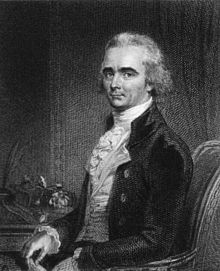William Roxburgh
| William Roxburgh | |
|---|---|

Engraving by Charles Turner Warren
|
|
| Born | 29 June 1751 Underwood, Craigie, Ayrshire |
| Died | 10 April 1815 (aged 63) Park Place, Edinburgh |
| Residence | Calcutta |
| Nationality | Scottish |
| Fields | surgeon, botanist |
| Doctoral advisor | John Hope |
| Author abbrev. (botany) | Roxb. |
William Roxburgh FRSE FRCPE FLS (3 or 29 June 1751 – 18 February 1815) was a Scottish surgeon and botanist who worked extensively in India, describing species and working on economic botany. He is known as the founding father of Indian botany. He published numerous works on Indian botany, illustrated by careful drawings made by Indian artists and accompanied by taxonomic descriptions of a large number of plant species. Apart from the numerous species that he named, many species were named in his honour by his collaborators.
The family details of Roxburgh and his birth are not known with certainty. He was born either on the 3rd or the 29th of June 1751 in the estate of Underwood in the parish of Craigie, Ayrshire or possibly Symington. His father may have worked in the Underwood estate or he may have been the illegitimate son of a well-connected family. His early education is thought to have been local and he probably studied Latin as demonstrated by his letters and some descriptions. He studied medicine at Edinburgh University and matriculated around 1771 or 1772. He lived with the well-connected family of Dr John Boswell at Edinburgh during this period. He studied surgery under Dr. Alexander Monro and learnt botany under John Hope. He was probably exposed to studies in mathematics and physics which would make him interested in precise quantification later in life in studies on hemp. He joined as a surgeon's mate on an East India Company ship Houghton in 1772 serving under surgeon Richard Ballantyne. He also served on the Queen in 1774. Several of these voyages took him to Madras and other ports in India. He joined the Madras Medical Service as an assistant surgeon on 28 May 1776 and was promoted to the rank of a surgeon in 1780. He received an M.D. on 12 January 1790 from Aberdeen college.
Roxburgh began work in the Carnatic from 1781 and replaced Patrick Russell as the Company Botanist in Madras on April 1789. His early work was on botany as superintendent in the Samalkot garden in the Northern Circars. Here he conducted economic botany experiments. He employed native artists to illustrate plants. He had 700 illustrations by 1790. He then succeeded Patrick Russell (1727–1805) as Naturalist to the Madras Government in April 1789. From 1793, he and Andrew Ross established a garden at Corcondah, where they worked on sugarcane and indigo. He also studied the prospects of introducing sago and other food crops to help alleviate the effect of famine. He was invoted to fill the position of Superintendent at the Calcutta Botanical Garden where the death of Colonel Robert Kyd had created a vacancy. He made rapid progress and acquired a good reputation and was later invited by the government of Bengal, to take charge of the Calcutta Botanical gardens from Colonel Robert Kyd in 1793 as Superintendent of the Company garden at Sibpur near Calcutta. A catalogue of the garden was made in 1814 – Hortus Bengalensis. He was succeeded by Francis Buchanan-Hamilton.
...
Wikipedia
